Morning Eye Candy: Purple Puffs
Posted in Photography on July 20 2015, by Matt Newman
Hydrangeas near Mosholu Gate – Photo by Ivo M. Vermeulen

Inside The New York Botanical Garden
Posted in Photography on July 20 2015, by Matt Newman
Hydrangeas near Mosholu Gate – Photo by Ivo M. Vermeulen
Posted in Adult Education on March 5 2015, by Lynden B. Miller
Lynden B. Miller is a public garden designer who rescued and restored the Conservatory Garden in Central Park and went on create many other public gardens in New York including our Perennial Garden and Ladies’ Border at NYBG.

The 2015 Winter Lecture Series concludes this month with Robert Mallet, director of the world’s largest hydrangea collection, presenting Gardens of Meaning. We asked renowned garden designer and historian Lynden B. Miller to tell us just how important the French plantsman’s work is for garden designers. Here’s what she told Plant Talk.
It is very exciting to have Robert Mallet coming to speak to us at NYBG on March 19. He is a great plantsman and designer. One of the first French horticulturists to promote the use of ornamental shrubs and perennials beginning in the 1980’s, he was also one of the founders of Courson, the great and very popular French biennial horticultural event (the French equivalent of the Chelsea Flower Show). His family’s house and garden in Normandy, Les Bois des Moutiers, is spectacular and—with an amazing collection of great plants—not to be missed on any garden trip to France.
Posted in Horticulture on December 3 2014, by Sonia Uyterhoeven
Sonia Uyterhoeven is NYBG‘s Gardener for Public Education.
 With Thanksgiving and the season’s first snow behind us, the reality of winter is now upon us. At this time of year the rose garden is closed to the public, but the gardeners are still busy working. Fall clean-up is important!
With Thanksgiving and the season’s first snow behind us, the reality of winter is now upon us. At this time of year the rose garden is closed to the public, but the gardeners are still busy working. Fall clean-up is important!
As every rose gardener knows, the queen of flowers is particularly susceptible to black spot. The spores of the fungus will happily over-winter in the soil around your roses. It is paramount to clean up all the diseased foliage and be meticulous about keeping the area around the rose clean.
Once our roses start to go dormant for the winter and the ground starts to cool, we surround the base of the plants with mulch. The mulch acts like a winter Parka, protecting the base of the rose during the cold winter months. We use a finely shredded bark mulch that doesn’t get matted down into large clumps. “Hilling” or mounding mulch around the base of our roses to a depth of 6 to 8 inches provides ample protection during the cold winter months.
Posted in Gardening Tips on October 9 2014, by Sonia Uyterhoeven
Sonia Uyterhoeven is NYBG‘s Gardener for Public Education.
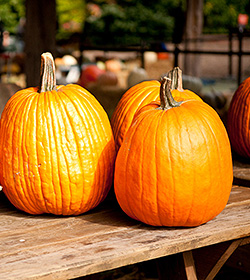 Every year, in celebration of Columbus Day and the advent of autumn, I conduct a Home Gardening Demonstration in the Fall Room of the Jane Watson Irwin Perennial Garden on autumnal centerpieces. Instead of getting my hands dirty, I get my hands gooey by carving exotic looking heirloom pumpkins and creating festive table arrangements.
Every year, in celebration of Columbus Day and the advent of autumn, I conduct a Home Gardening Demonstration in the Fall Room of the Jane Watson Irwin Perennial Garden on autumnal centerpieces. Instead of getting my hands dirty, I get my hands gooey by carving exotic looking heirloom pumpkins and creating festive table arrangements.
I stand above the pumpkins with a sharp knife, grasp the stem for stability and start carving open the top. If you are carving a pumpkin with the intention of replacing the lid then you would place the knife at a 45-degree angle. Since I am carving with the intention of inserting a 4-inch square vase inside as a centerpiece holder, I carve straight down at a 90-degree angle. My objective is to create a clean edge and an area that is large enough so I can slip the vase in, leaving a small amount of wiggle room so that I can extract it with ease.
Posted in Horticulture on August 12 2014, by Sonia Uyterhoeven
Sonia Uyterhoeven is the NYBG’s Gardener for Public Education.
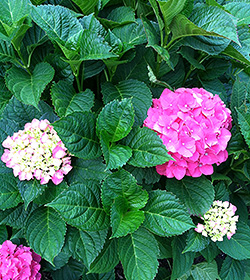
As we read in my post last week, it has been a difficult year for bigleaf hydrangeas (the mophead and lacecap hydrangeas) due to the late frosts in the spring which killed off many of the flowering buds. While weather is often the culprit for the demise of good flowering in hydrangeas, sometimes other factors come into play.
The lessons from this past year are clear: hydrangeas that flower on second-year wood (i.e., where the flower buds form in the previous season) are best sited in protected areas that are not exposed to harsh winter elements, such as strong winds and extreme temperature fluctuations.
Other factors can contribute to a lack of flowers. Too much shade will also hamper flower production, as will fertilizing too often with high nitrogen fertilizers—this will simply produce leafy growth with few flowers. Over- and under-watering your hydrangeas can also weaken the plant and prevent maximum flowering.
Posted in Horticulture on August 6 2014, by Sonia Uyterhoeven
Sonia Uyterhoeven is the NYBG’s Gardener for Public Education.
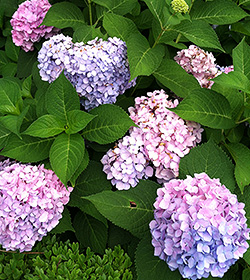
Earlier this season, Todd Forrest posted a blog entitled “Waiting for Hydrangeas”. He spoke of the cold spring we had where temperatures plummeted below freezing, destroying many hydrangea flower buds that were waiting to bloom this season.
While panicle hydrangeas (Hydrangea paniculata) and smooth hydrangeas (Hydrangea arborescens) flower on new wood, the bigleaf, mophead, and lacecap hydrangeas (Hydrangea macrophylla) that we all adore, flower primarily on old wood with the flower buds forming the previous season.
The re-blooming or remontant type that flower on both old and new wood have, as predicted, fared very well. We have a large planting of Endless Summer® at the train station entrance of the Garden at the Moshulu Gate. It has been flowering beautifully for the past month with new flowers starting to form as older ones fade. The first year these hydrangeas were planted the flowering was sparse, but now that they have established a solid root system and settled in they are floriferous.
Posted in Photography on June 29 2014, by Lansing Moore
This oakleaf hydrangea brings a wintry refreshment to these languid summer days.
Hydrangea quercifolia Snowflake™ in the Forest – Photo by Ivo M. Vermeulen
Posted in Horticulture on May 30 2014, by Todd Forrest
Todd Forrest is the NYBG’s Arthur Ross Vice President for Horticulture and Living Collections. He leads all horticulture programs and activities across the Garden’s 250-acre National Historic Landmark landscape, including 50 gardens and plant collections outside and under glass, the old-growth Thain Family Forest, and living exhibitions in the Enid A. Haupt Conservatory.
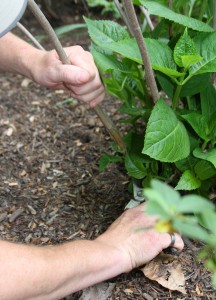
On April 16 at 6 a.m., the Garden’s weather station reported a low temperature of 30.2°F. The freezing temperatures were accompanied by about a half inch of icy slush that coated the greening turf and accumulated in the chalices formed by the opening flowers of saucer magnolias, which had just emerged after a string of warm April days that, I hoped, signaled the end of our seemingly interminable winter. Needless to say, the Garden’s venerable saucer magnolias did not have their best spring.
For many, memories of that hard April frost will be erased by this week’s temperatures—approaching 90°F as I write—and the reappearance of seersucker suits in midtown. Those of us who love plants will be reminded of April 16 every time we see an old-fashioned Hydrangea macrophylla over the next few months. With the exception of remontant (re-blooming) varieties such as Endless Summer® (more on these later), Hydrangea macrophylla flower from buds formed during the previous growing season. Dormant through the long winter, these buds began to swell as temperatures finally rose in early April, only to be zapped by the hard mid-April frost.
Posted in Gardening Tips, Gardens and Collections on July 2 2013, by Sonia Uyterhoeven
Sonia Uyterhoeven is the NYBG‘s Gardener for Public Education.
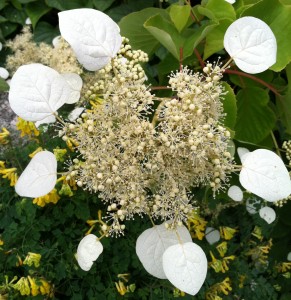
I often have visitors tell me that they love perennials, but their big challenge as gardeners is finding combinations that make it easy to synchronize bloom times. This is a real challenge particularly when the desire to create appealing plant partners meets a wish to provide multi-seasonal interest in the garden.
Annuals are an easy way to ensure season-long color, but they often lack the textures, stature, and architectural interest that perennials supply. In my walks around the Garden this year I have found two “garden moments” worth sharing—one serendipitous, the other planned. They are instructive examples in creating satisfying designs with limited plant palettes in your garden.
A few years ago, on a low stone wall in the Home Gardening Center, I planted a climbing hydrangea (Schizophragma hydrangeoides ‘Moonlight’). The climbing hydrangea is a woody vine that has blue-green, heart-shaped leaves and creamy white lace-cap flowers. It has stretched itself happily over the stone wall and filled in nicely.
Since the vine wants to crawl on the stone wall we needed to fill the space below, by its feet, and along the edge of the border. Lady’s mantle (Alchemilla mollis) seemed like a logical choice. This perennial only grows 12-18” tall and forms a nice clump, with large, scalloped, light-green to blue-green foliage. Furthermore, lady’s mantle flowers alongside the climbing hydrangea in June, producing clusters of showy chartreuse flowers.
Posted in Around the Garden, Photography on June 30 2013, by Matt Newman
Hydrangea macrophylla ‘Endless Summer’ — Photo by Ivo M. Vermeulen